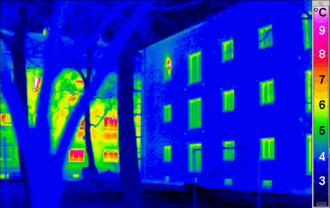
| Part of a series on |
| Sustainable energy |
|---|
 |
A low-energy house is characterized by an energy-efficient design and technical features which enable it to provide high living standards and comfort with low energy consumption and carbon emissions. Traditional heating and active cooling systems are absent, or their use is secondary.[1][2] Low-energy buildings may be viewed as examples of sustainable architecture. Low-energy houses often have active and passive solar building design and components, which reduce the house's energy consumption and minimally impact the resident's lifestyle. Throughout the world, companies and non-profit organizations provide guidelines and issue certifications to guarantee the energy performance of buildings and their processes and materials. Certifications include passive house, BBC—Bâtiment Basse Consommation—Effinergie (France), zero-carbon house (UK), and Minergie (Switzerland).[3]
Buildings alone were responsible for 38% of all human Greenhouse gas emissions (GHG) as of 2008, with 20% attributed to residential buildings and 18% to commercial buildings.[4] According to the Intergovernmental Panel on Climate Change (IPCC), buildings is the sector which presents the most cost effective opportunities for GHG reductions.[5]
- ^ Thomas, Walter D.; Duffy, John J. (2013-12-01). "Energy performance of net-zero and near net-zero energy homes in New England". Energy and Buildings. 67: 551–558. doi:10.1016/j.enbuild.2013.08.047. ISSN 0378-7788.
- ^ Weißenberger, Markus; Jensch, Werner; Lang, Werner (2014-06-01). "The convergence of life cycle assessment and nearly zero-energy buildings: The case of Germany". Energy and Buildings. 76: 551–557. doi:10.1016/j.enbuild.2014.03.028. ISSN 0378-7788.
- ^ "International Passive House Association | Criteria". passivehouse-international.org. Retrieved 2019-04-07.
- ^ U.S. EPA. 2008. Inventory of U.S. Greenhouse Gases Emissions and Sinks: 1990-2006, p. ES8.
- ^ IPCC. 2007. Climate Change 2007 Synthesis Report, p. 59.